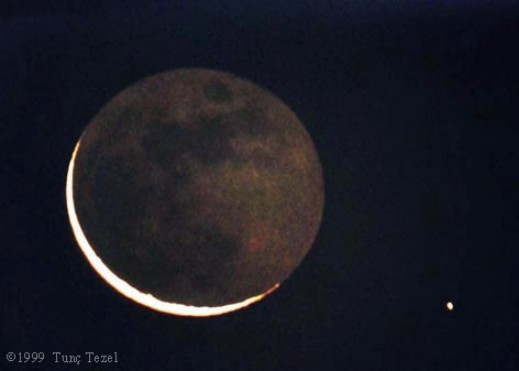Credit & Copyright: Tunc Tezel
Explanation:
Mercury is the closest planet to the Sun and
never moves far from our parent
star in Earth's sky.
Racing around its tight orbit, this well-done world
is a little over 1/3 the diameter of Earth and
is often lost to
our view in the solar glare.
But, just one day before the August 11 total
solar eclipse, astronomer
Tunc Tezel captured this fleeting view of a close conjunction of Mercury
and the soon to be
silhouetted Moon as seen from Turkey.
Mercury at the lower right shines brightly in reflected
sunlight
while only a thin crescent of the almost new
Moon is directly illuminated.
The rest of the lunar nearside is faintly visible though,
illuminated by light from an
almost full Earth.
On Monday,
November 15th, Mercury will actually be seen to
transit or pass across the disk of the Sun for well placed
observers in the
pacific hemisphere.
1999 2000 2001 2002 2003 2004 2005 2006 2007 2008 2009 2010 2011 2012 2013 2014 2015 2016 2017 2018 2019 2020 2021 2022 2023 2024 2025 |
Yanvar' Fevral' Mart Aprel' Mai Iyun' Iyul' Avgust Sentyabr' Oktyabr' Noyabr' Dekabr' |
NASA Web Site Statements, Warnings, and Disclaimers
NASA Official: Jay Norris. Specific rights apply.
A service of: LHEA at NASA / GSFC
& Michigan Tech. U.
|
Publikacii s klyuchevymi slovami:
Mercury - conjunction - Moon - Luna - Merkurii - Soedinenie planet
Publikacii so slovami: Mercury - conjunction - Moon - Luna - Merkurii - Soedinenie planet | |
Sm. takzhe:
Vse publikacii na tu zhe temu >> | |
